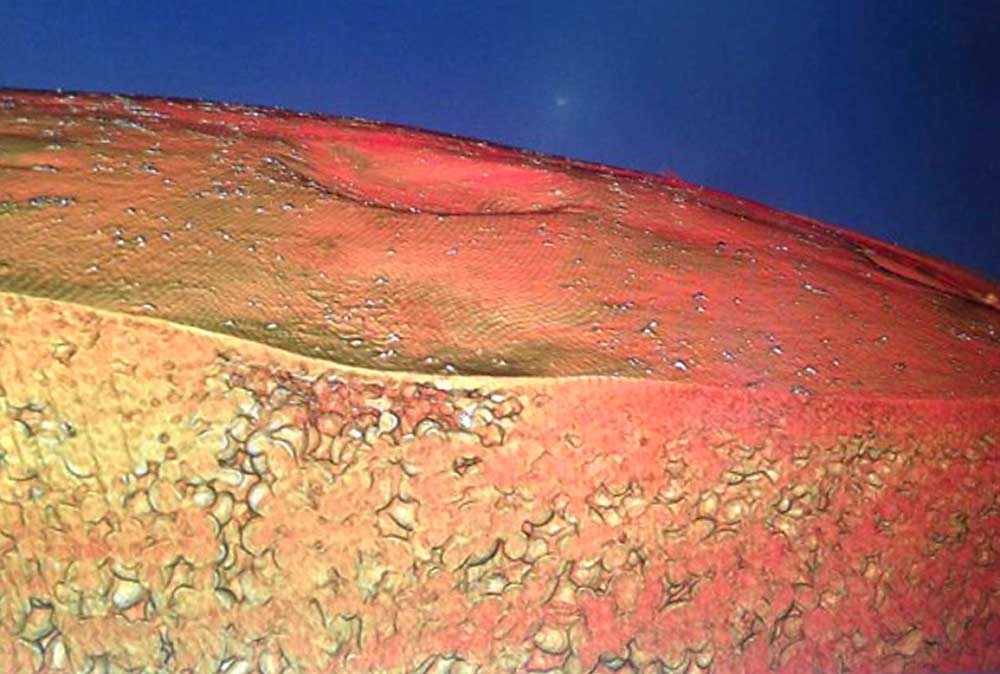
Imaging of an apple’s structure reveals a network of veins, which transport calcium throughout the fruit. But a lack of veins near the calyx, as shown in this Honeycrisp, explains why bitter pit typically develops first in the calyx, said Washington State University physiologist Lee Kalcsits. (Courtesy Tamas Varga)
The idea of sending sick apples for a CT scan sounds a little far-fetched, but insights from the resulting imagery is helping researchers find solutions for one of the industry’s most vexing disorders: bitter pit in Honeycrisp.
Using a particle accelerator (really!) at the Advanced Light Source synchrotron at Lawrence Berkeley National Lab in Berkeley, California, that harnesses electrons traveling near the speed of light to conduct high resolution scans of apples, physiologist Lee Kalcsits was able to see that the cell structure of Honeycrisp with bitter pit is very different than healthy fruit and that, compared to other apple varieties, there are structural reasons why Honeycrisp is more at risk of developing the disorder.
“When we look at all the slices, it allows us to look at the structural integrity of the fruit,” said Kalcsits, a Washington State University scientist who is working with University of Kentucky researcher Dave McNear to do the apple imaging.
Kalcsits presented the Robert F. Carlson Lecture on his research into bitter pit physiology and potential horticultural solutions, including irrigation management, during the International Fruit Tree Association annual conference in Napier, New Zealand.
At the scale of individual apple cells, apples with bitter pit have more air space and more pores than healthy apples with good structure.
Kalcsits says affected apples have lots of dead cells in clumps of 20 to 30 that create the lesions we can see and identify as bitter pit as well as very tiny two- or three-cell specks affected throughout the fruit. So what we call bitter pit is far more pervasive than just the pits we see.
“This structure is important to decreasing bitter pit incidence,” said Kalcsits, who acknowledged that the primary driver of this issue is inherent to Honeycrisp’s genetics. “Of course, you are still limited by your scion and rootstock genetics, you are still limited by environment, depending on where you might grow your fruit, but there are horticultural strategies you can use to control bitter pit.”
Two of the primary horticultural tools will certainly not surprise any Honeycrisp grower: good crop load management and calcium sprays. But Kalcsits explained why calcium matters so much to fruit structure and why growers get such variable results, even when they are doing everything right.
“If you are doing everything right, it can still go wrong, and that’s what is so frustrating with Honeycrisp. What is this variability? All these orchards thinning to the proper crop load, all doing weekly calcium sprays, and they are all fifth to seventh leaf orchards on M.9. (But) some orchards get 3 percent bitter pit and some get 38 percent bitter pit,” he said, describing the orchards in one of his studies.
“So what we’ve found is that it’s actually water,” Kalcsits continued. “When all other factors are controlled, water can drive fruit size. You can use irrigation to get fruit size down and control bitter pit.”
Trees under slight amounts of water stress produce smaller fruit than trees with access to an abundant amount of water. Kalcsits’s research into how best to use irrigation deficits to control fruit size and bitter pit is still in its early days, but preliminary results suggest that it’s a needed tool to hit proper sizes.

This close up image of the cell structure near the surface of a Honeycrisp apple shows the development of internal bitter pit in the more reddish clump of dead cells just below the surface. (Courtesy Lee Kalcsits)
The insight into how exactly irrigation controls bitter pit came from those high-resolution images of apple cell structure. Honeycrisp naturally have bigger cells than most apples, Kalcsits said. That seems to predispose them to structural degradation associated with bitter pit. And trees that have access to extra water allow those cells to grow even bigger, while limited water during the later stages of fruit growth can keep the fruit cells a little smaller and more stable.
Inside an apple, the cells are held together by a glue-like layer known as the middle lamella, which is made out of pectins bound up with calcium. When the fruit starts to ripen, that glue breaks down, but it breaks down much faster if the fruit has low calcium, Kalcsits said.
The challenge is getting sufficient calcium into the fruit to create that sturdy glue to resist bitter pit development. Calcium is carried up from the roots into the tree through transpiration of water, but it can’t move by itself.
“Where it ends up depends on how much water that organ, that leaf or that fruit, is using,” Kalcsits said. But since leaves use a lot of water, they end up with most of the calcium, especially in vigorous trees or high transpiration conditions. And unlike nitrogen or potassium, the plant can’t pull calcium from its leaves and move it to the fruit where it’s needed.
“That’s why you get bitter pit in fruit, because calcium is relatively nonmobile. Cork spot in pears, tomato end rot, it’s all the same issue with a lack of ability to get calcium to tissues,” he said. “Just because you have good calcium rates in the soil, it doesn’t necessarily translate to low bitter pit incidence in the orchard because of how the tree processes it.”
Growers try to get around this problem with calcium sprays directly on the fruit. But how well do they really work? Kalcsits and his collaborators used a tracer form of calcium chloride to see how much of the applied product is getting into the fruit.
They found that no matter when in the season you spray, some calcium is getting into the fruit, but it’s not as efficient as growers might hope: about 25 percent absorption into the peel and flesh combined or about 10 percent into the flesh itself, Kalcsits said.
That’s why calcium sprays are important, but not a silver bullet. Careful crop load and irrigation management will help control fruit size and give Honeycrisp a better shot of avoiding bitter pit and making the most of the calcium it can get.
Much of this research remains underway, but Kalcsits expects to have more detailed results and recommendations for growers in the next few years.
Better understanding of bitter pit physiology and the role of genetics will also benefit efforts to breed new apple varieties not prone to these problems and find rootstocks that can help move more calcium into Honeycrisp.
In that way, Kalcsits’ research aligns well with a recently funded USDA-NIFA Specialty Crop Research Initiative Project known as AppleRoot2Fruit that seeks to understand and better harness the ability of rootstocks to improve horticulture, nutrition, disease resistance and the overall sustainability of the industry, led by Lailiang Cheng of Cornell University, Kalcsits, and colleagues from five other U.S. institutions. •
—by Kate Prengaman
Correction: This story was originally published with an incorrect spelling of Tamas Varga. Good Fruit Grower regrets the error.






Leave A Comment